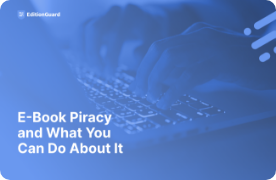(Source: Adobe)
Why is Piracy a Problem for Libraries?
While a well-stocked library has much to offer for communities, libraries are also at risk of piracy both online and off. Although libraries lend books, e-books, and other materials to members free of charge for limited periods of time, the libraries themselves have already paid for those resources. In fact, libraries typically pay a significantly higher rate to publishers per title than bookstores. Libraries operate on a lending schedule that includes overdue fees to guarantee that materials return to the shelves. However, piracy poses a threat to both the continuing existence of local libraries and online ones. Public libraries typically rely almost exclusively on government funding to survive, while university and college libraries rely on funding from those institutions. If borrowing rates and member enrollment decline due to books being readily available through piracy, it is almost guaranteed to have a negative impact on funding.(Source: Adobe)
Online Libraries
One survey shows that nearly half of e-book consumers had downloaded at least one pirated book in the previous 12 months. Not only does illegal use of content violate authors and publishers copyrights on materials, but it also undermines library borrowing. Because many libraries now offer digital borrowing, they are competing directly with illegal free book platforms that don’t have due dates and membership agreements. With most online libraries, borrowing schedules follow a traditional timeframe of one to three weeks, and on their due date, they simply disappear from the reader’s digital library. When consumers realize they can obtain e-books, audiobooks, and more for free—and retain them permanently—they are less likely to utilize library services. At the same time, libraries struggle to stay relevant as many consumers turn to digital media consumption rather than traditional books.(Source: Adobe Stock)
Traditional Libraries
The emergence of the e-book has posed a challenge to the conventional library model from day one. Libraries have traditionally relied upon the physical experience of viewing and reading books to attract borrowers, justify their funding and provide exposure for new authors. Convenience and lack of overdue fees are just two reasons why consumers may opt for pirated content rather than visiting a brick-and-mortar library location. This puts pirates in direct competition with libraries. Not only libraries at risk. As industry experts note, libraries (and bookstores) serve as crucial intermediaries between authors, publishers, and readers. Without library displays of “What’s Hot” titles and new releases, books sales may be adversely affected. At the same time, the migration to e-reading may threaten the sales of physical books. People still maintain a desire to read, but they want a no-risk and convenient way to do so. Unfortunately, pirated content may appear to be the most accessible and risk-free commitment.What Are Authors and Publishers Doing to Protect Books from Piracy?
Fortunately, there are steps authors and publishers can take to protect books from piracy before they end up on library shelves- digital or otherwise.Industry-Standard DRM Encryption
Industry-Standard DRM encryption prevents e-books from online duplication and unauthorized use through secure code. This security depends on rapidly changing technology and is one of the most stringent measures against e-book piracy. Authors or publishers must add encryption before their books arrive at the library, limiting the way that readers can use them. For example, readers cannot print or copy an encrypted book. Encryption can also dictate what devices and applications users can read on. E-books and audiobooks may arrive without DRM encryption, allowing libraries to select their own methods of security that are uniform across all content types. Encryption depends on the author or publisher’s preferences, and more popular titles may arrive at the library with pre-existing encryption protection. This limits a library’s choices when it comes to lending terms and device compatibility.Watermarking or “Social DRM”
Watermarking can prevent readers from carelessly sharing content because watermarks can display copyright information and penalties and use the reader’s personal information as a marker. With Social DRM, authors and publishers place a visible watermark on the inside of an e-book so that pirated copies can be attributed to the original downloader. Some forms of digital watermarking can also be invisible, allowing publishers to sweep the internet for pirated e-books in circulation. Audiobooks, PDF files, and other resources can also use invisible digital watermarking to seamlessly “tag” content. If a pirate copies a resource with an invisible digital watermark, this “tag” allows publishers or authors to track the media and take legal action.Why Do Libraries Need DRM?
Libraries hold a unique position as the middleman between authors or publishers and their readers. Because of this position, libraries want freely accessible content to pass on to consumers, but they must also cater to the wishes of authors and publishers. Libraries’ concerns include consumer privacy, accessibility for users with disabilities, and enforcing DRM restrictions. Keeping electronic media both readily accessible and protected from piracy is a tall order, but DRM solutions can achieve both. Ultimately, libraries need visitors so that they can keep their doors open. If people are obtaining e-books and other resources illegally, that means fewer visitors for libraries. People who can download, copy, and share books from home often won’t bother logging in or visiting their local library to find a good read. DRM keeps library resources secure and creates a demand for books that are not found online for free. If libraries can encourage this demand, they will continue to see traffic from readers who lack access to pirated materials.(Source: Adobe)







